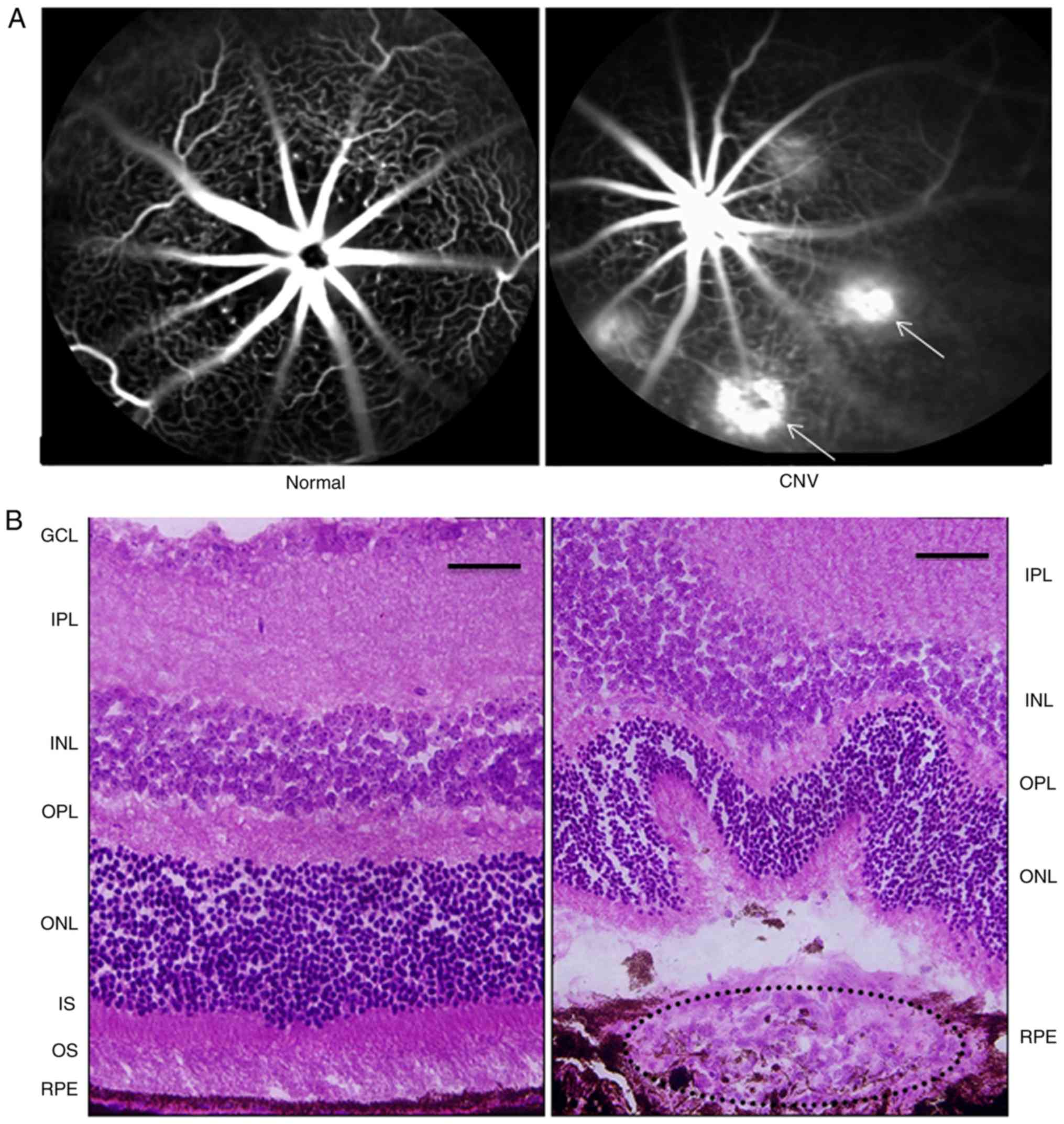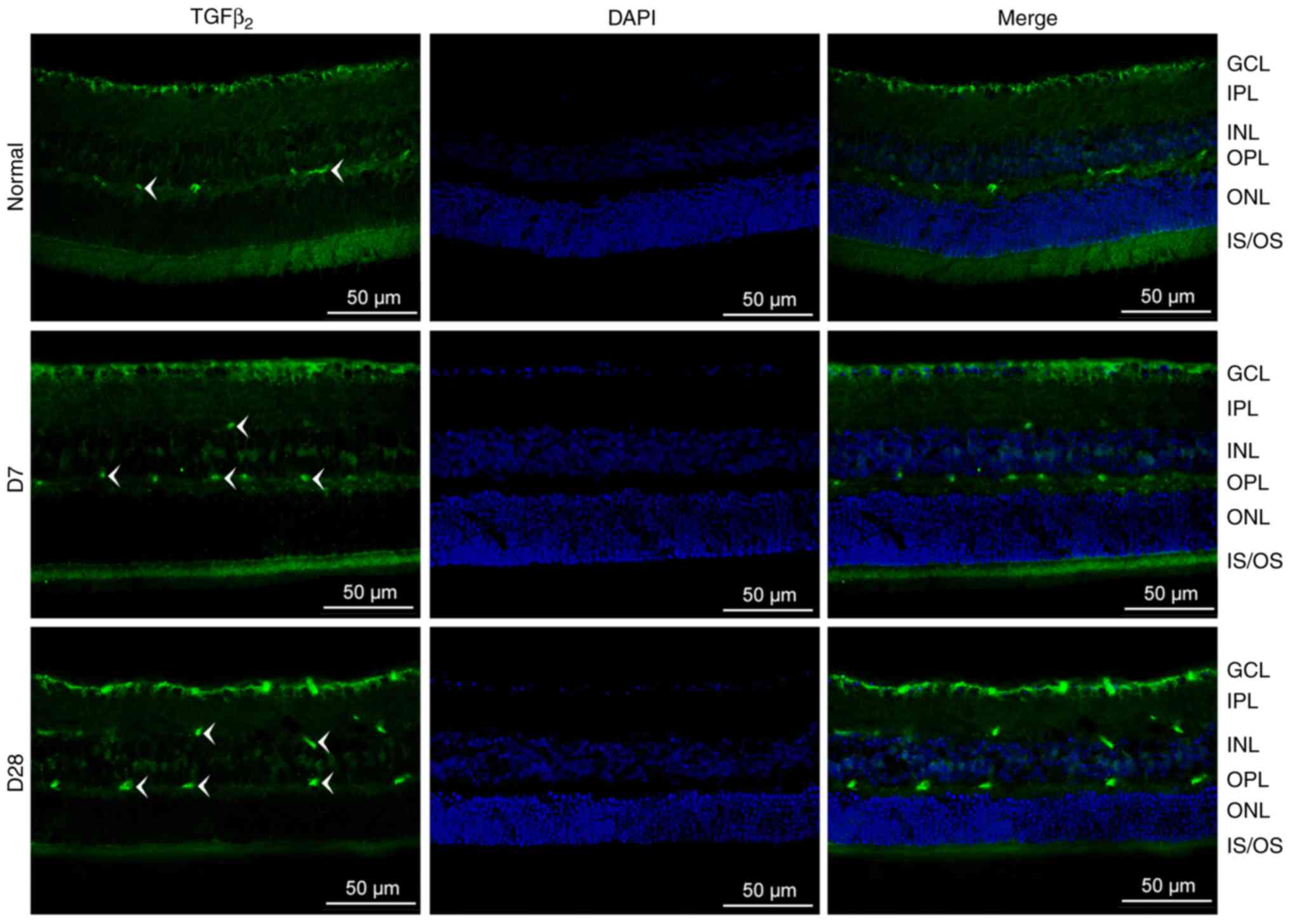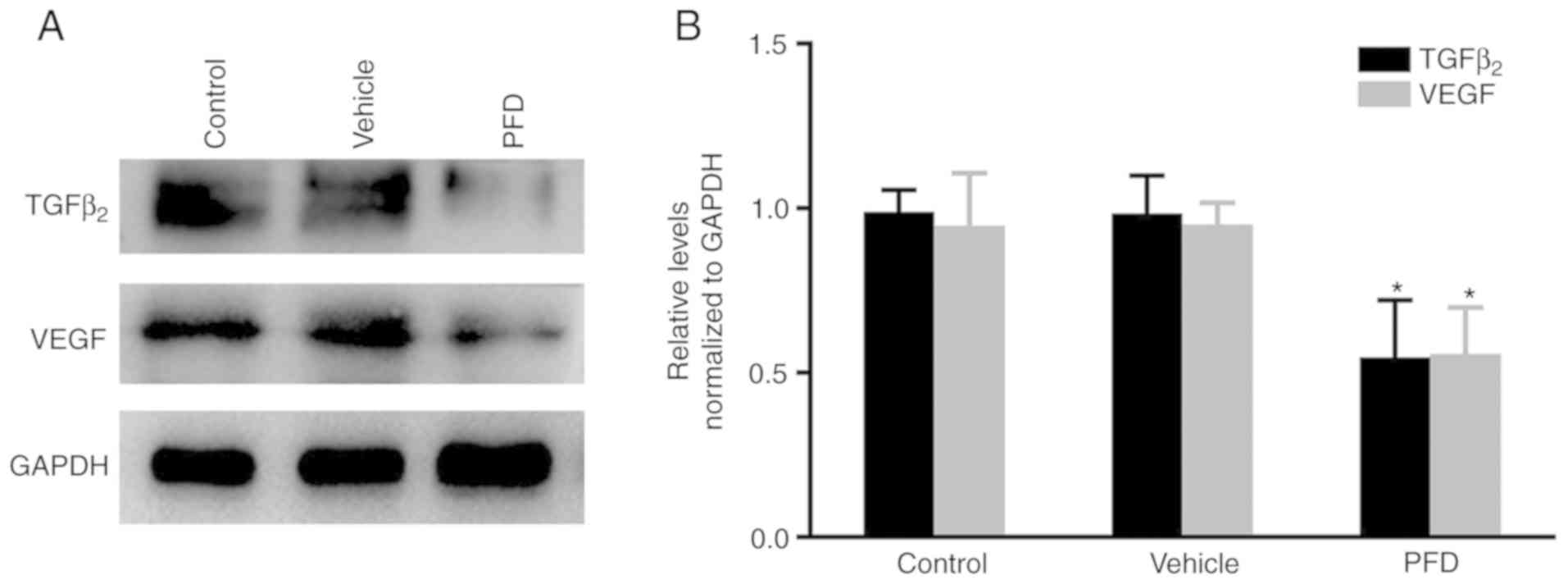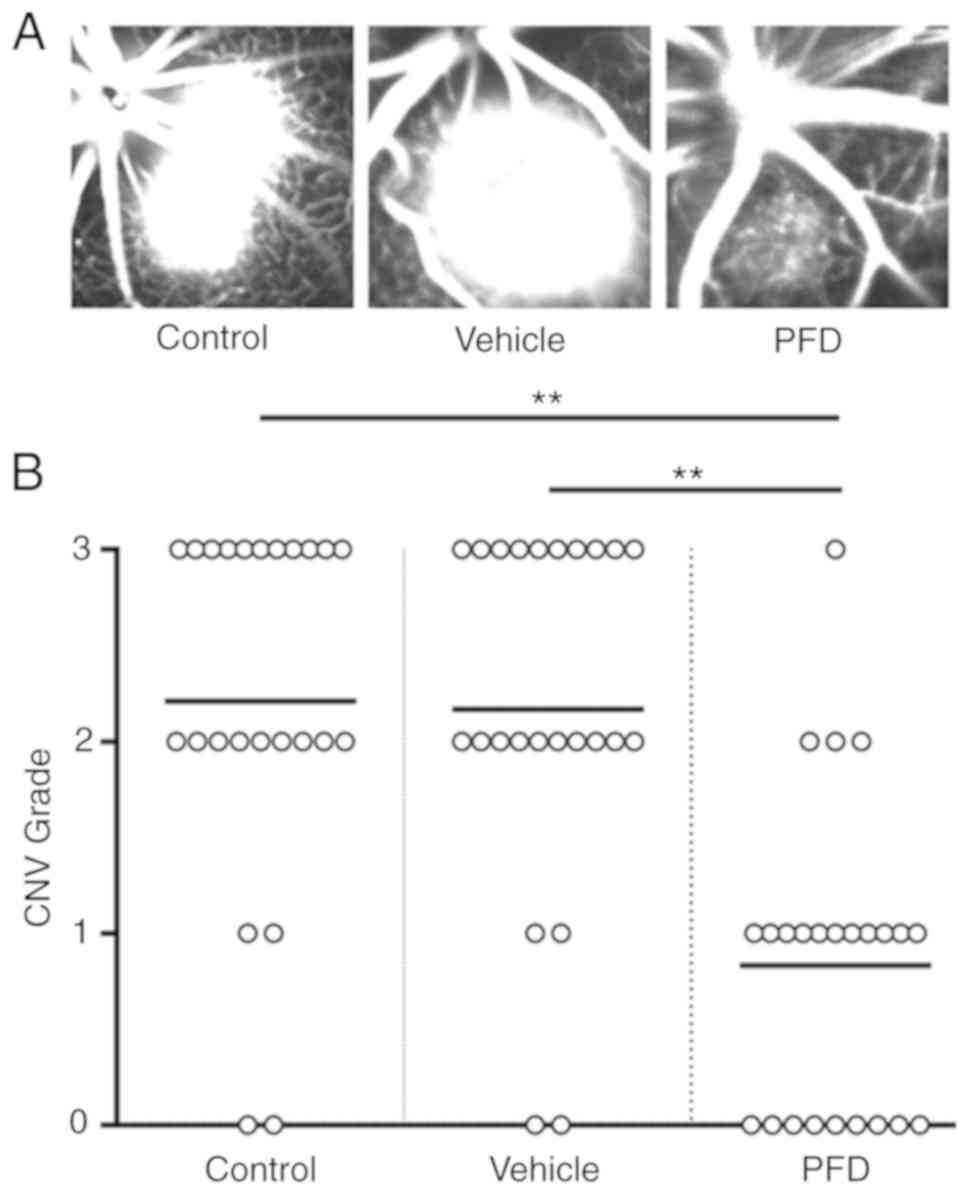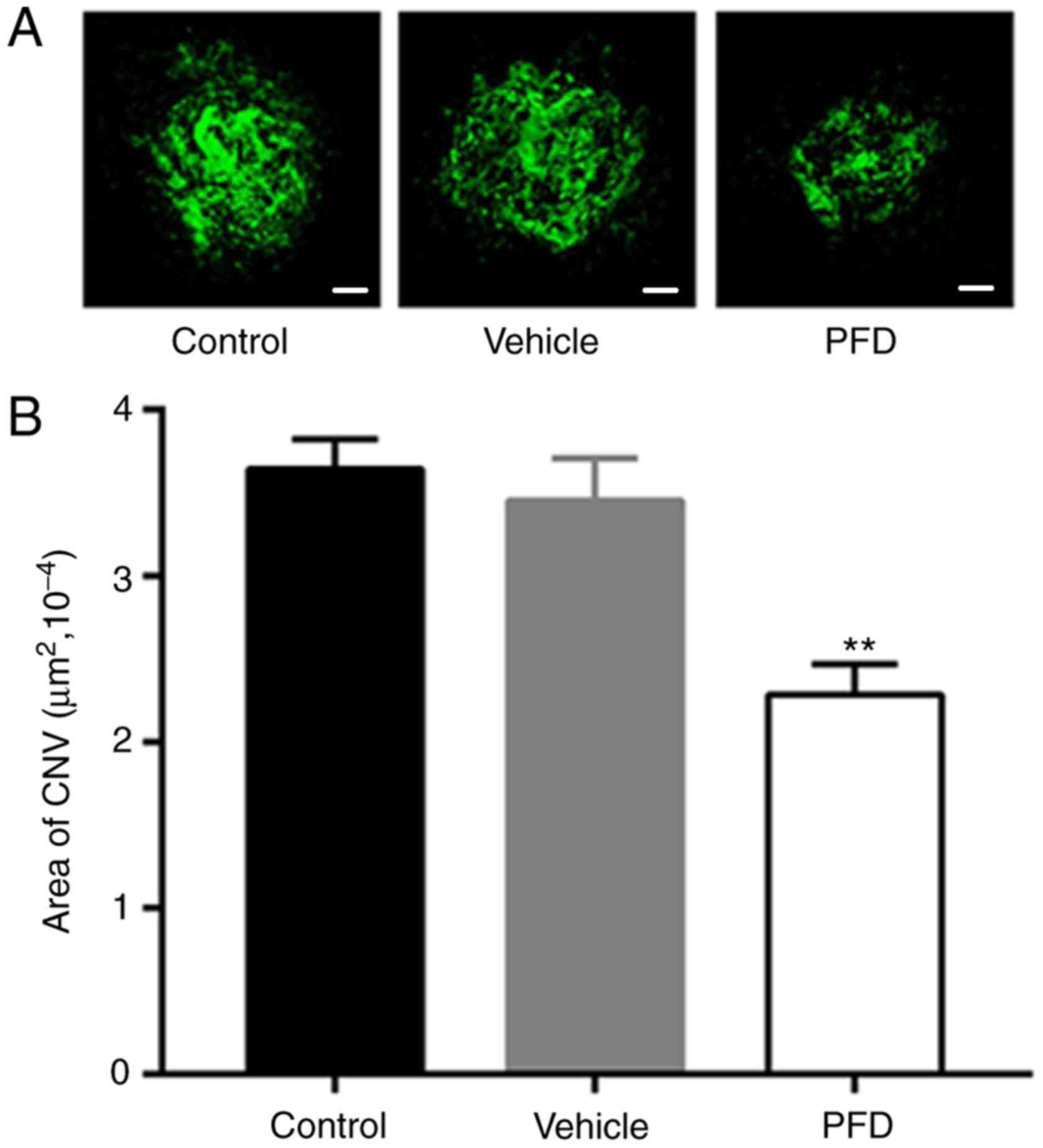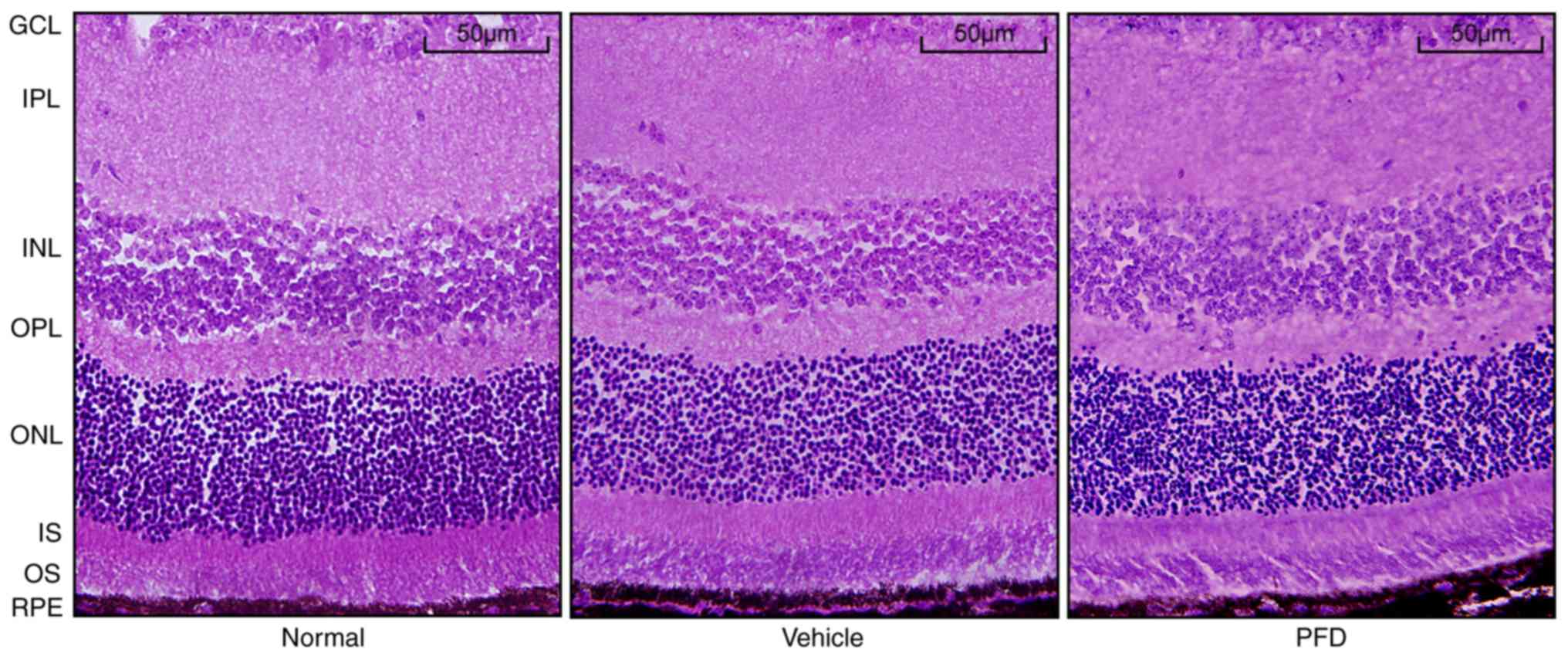|
1
|
Gehrs KM, Anderson DH, Johnson LV and
Hageman GS: Age-related macular degeneration-emerging pathogenetic
and therapeutic concepts. Ann Med. 38:450–471. 2006. View Article : Google Scholar : PubMed/NCBI
|
|
2
|
Ambati J and Fowler BJ: Mechanisms of
age-related macular degeneration. Neuron. 75:26–39. 2012.
View Article : Google Scholar : PubMed/NCBI
|
|
3
|
Campa C, Costagliola C, Incorvaia C,
Sheridan C, Semeraro F, De Nadai K, Sebastiani A and Parmeggiani F:
Inflammatory mediators and angiogenic factors in choroidal
neovascularization: Pathogenetic interactions and therapeutic
implications. Mediators Inflamm. 2010:2010. View Article : Google Scholar : PubMed/NCBI
|
|
4
|
Ambati J, Atkinson JP and Gelfand BD:
Immunology of age-related macular degeneration. Nat Rev Immunol.
13:438–451. 2013. View
Article : Google Scholar : PubMed/NCBI
|
|
5
|
van Lookeren Campagne M, LeCouter J,
Yaspan BL and Ye W: Mechanisms of age-related macular degeneration
and therapeutic opportunities. J Pathol. 232:151–164. 2014.
View Article : Google Scholar : PubMed/NCBI
|
|
6
|
Recalde S, Zarranz-Ventura J,
Fernández-Robredo P, García-Gómez PJ, Salinas-Alamán A,
Borrás-Cuesta F, Dotor J and García-Layana A: Transforming growth
factor-β inhibition decreases diode laser-induced choroidal
neovascularization development in rats: P17 and P144 peptides.
Invest Ophthalmol Vis Sci. 52:7090–7097. 2011. View Article : Google Scholar : PubMed/NCBI
|
|
7
|
Zarranz-Ventura J, Fernández-Robredo P,
Recalde S, Salinas-Alamán A, Borrás-Cuesta F, Dotor J and
García-Layana A: Transforming growth factor-beta inhibition reduces
progression of early choroidal neovascularization lesions in rats:
P17 and P144 peptides. PLoS One. 8:e654342013. View Article : Google Scholar : PubMed/NCBI
|
|
8
|
Ding D, Li C, Zhao T, Li D, Yang L and
Zhang B: LncRNA H19/miR-29b-3p/PGRN axis promoted
epithelial-mesenchymal transition of colorectal cancer cells by
acting on Wnt signaling. Mol Cells. 41:423–435. 2018.PubMed/NCBI
|
|
9
|
Verrecchia F and Rédini F: Transforming
growth factor-β signaling plays a pivotal role in the interplay
between osteosarcoma cells and their microenvironment. Front Oncol.
8:1332018. View Article : Google Scholar : PubMed/NCBI
|
|
10
|
Stewart AG, Thomas B and Koff J: TGF-β:
Master regulator of inflammation and fibrosis. Respirology.
23:1096–1097. 2018. View Article : Google Scholar : PubMed/NCBI
|
|
11
|
Kita T, Hata Y, Arita R, Kawahara S, Miura
M, Nakao S, Mochizuki Y, Enaida H, Goto Y, Shimokawa H, et al: Role
of TGF-beta in proliferative vitreoretinal diseases and ROCK as a
therapeutic target. Proc Natl Acad Sci USA. 105:17504–17509. 2008.
View Article : Google Scholar : PubMed/NCBI
|
|
12
|
Saika S: TGFbeta pathobiology in the eye.
Lab Invest. 86:106–115. 2006. View Article : Google Scholar : PubMed/NCBI
|
|
13
|
Bressler SB: Introduction: Understanding
the role of angiogenesis and antiangiogenic agents in age-related
macular degeneration. Ophthalmology. 116:S1–S7. 2009. View Article : Google Scholar : PubMed/NCBI
|
|
14
|
Nagineni CN, Samuel W, Nagineni S,
Pardhasaradhi K, Wiggert B, Detrick B and Hooks JJ: Transforming
growth factor-beta induces expression of vascular endothelial
growth factor in human retinal pigment epithelial cells:
Involvement of mitogen-activated protein kinases. J Cell Physiol.
197:453–462. 2003. View Article : Google Scholar : PubMed/NCBI
|
|
15
|
Yamagami K, Oka T, Wang Q, Ishizu T, Lee
JK, Miwa K, Akazawa H, Naito AT, Sakata Y and Komuro I: Pirfenidone
exhibits cardioprotective effects by regulating myocardial fibrosis
and vascular permeability in pressure-overloaded hearts. Am J
Physiol Heart Circ Physiol. 309:H512–H522. 2015. View Article : Google Scholar : PubMed/NCBI
|
|
16
|
Iyer SN, Hyde DM and Giri SN:
Anti-inflammatory effect of pirfenidone in the bleomycin-hamster
model of lung inflammation. Inflammation. 24:477–491. 2000.
View Article : Google Scholar : PubMed/NCBI
|
|
17
|
Selvaggio AS and Noble PW: Pirfenidone
initiates a new era in the treatment of idiopathic pulmonary
fibrosis. Annu Rev Med. 67:487–495. 2016. View Article : Google Scholar : PubMed/NCBI
|
|
18
|
King TE Jr, Bradford WZ, Castro-Bernardini
S, Fagan EA, Glaspole I, Glassberg MK, Gorina E, Hopkins PM,
Kardatzke D, Lancaster L, et al: A phase 3 trial of pirfenidone in
patients with idiopathic pulmonary fibrosis. N Engl J Med.
370:2083–2092. 2014. View Article : Google Scholar : PubMed/NCBI
|
|
19
|
Noble PW, Albera C, Bradford WZ, Costabel
U, du Bois RM, Fagan EA, Fishman RS, Glaspole I, Glassberg MK,
Lancaster L, et al: Pirfenidone for idiopathic pulmonary fibrosis:
Analysis of pooled data from three multinational phase 3 trials.
Eur Respir J. 47:243–253. 2016. View Article : Google Scholar : PubMed/NCBI
|
|
20
|
Sharma K, Ix JH, Mathew AV, Cho M,
Pflueger A, Dunn SR, Francos B, Sharma S, Falkner B, McGowan TA, et
al: Pirfenidone for diabetic nephropathy. J Am Soc Nephrol.
22:1144–1151. 2011. View Article : Google Scholar : PubMed/NCBI
|
|
21
|
Lopez-de la Mora DA, Sanchez-Roque C,
Montoya-Buelna M, Sanchez-Enriquez S, Lucano-Landeros S,
Macias-Barragan J and Armendariz-Borunda J: Role and new insights
of pirfenidone in fibrotic diseases. Int J Med Sci. 12:840–847.
2015. View Article : Google Scholar : PubMed/NCBI
|
|
22
|
Ishikawa K, Kannan R and Hinton DR:
Molecular mechanisms of subretinal fibrosis in age-related macular
degeneration. Exp Eye Res. 142:19–25. 2016. View Article : Google Scholar : PubMed/NCBI
|
|
23
|
Liu X, Zhu M, Yang X, Wang Y, Qin B, Cui
C, Chen H and Sang A: Inhibition of RACK1 ameliorates choroidal
neovascularization formation in vitro and in vivo. Exp Mol Pathol.
100:451–459. 2016. View Article : Google Scholar : PubMed/NCBI
|
|
24
|
Samuels BC, Siegwart JT, Zhan W, Hethcox
L, Chimento M, Whitley R, Downs JC and Girkin CA: A novel tree
shrew (Tupaia belangeri) model of glaucoma. Invest Ophthalmol Vis
Sci. 59:3136–3143. 2018. View Article : Google Scholar : PubMed/NCBI
|
|
25
|
Khanum BNMK, Guha R, Sur VP, Nandi S,
Basak SK, Konar A and Hazra S: Pirfenidone inhibits post-traumatic
proliferative vitreoretinopathy. Eye (Lond). 31:1317–1328. 2017.
View Article : Google Scholar : PubMed/NCBI
|
|
26
|
Shah RS, Soetikno BT, Lajko M and Fawzi
AA: A mouse model for laser-induced choroidal neovascularization. J
Vis Exp. e535022015.PubMed/NCBI
|
|
27
|
Liu B, Gao J, Lyu BC, Du SS, Pei C, Zhu ZQ
and Ma B: Expressions of TGF-β2, bFGF and ICAM-1 in lens epithelial
cells of complicated cataract with silicone oil tamponade. Int J
Ophthalmol. 10:1034–1039. 2017.PubMed/NCBI
|
|
28
|
Hulin A, Deroanne CF, Lambert CA, Dumont
B, Castronovo V, Defraigne JO, Nusgens BV, Radermecker MA and
Colige AC: Metallothionein-dependent up-regulation of TGF-β2
participates in the remodelling of the myxomatous mitral valve.
Cardiovasc Res. 93:480–489. 2012. View Article : Google Scholar : PubMed/NCBI
|
|
29
|
Wang X, Ma W, Han S, Meng Z, Zhao L, Yin
Y, Wang Y and Li J: TGF-β participates choroid neovascularization
through Smad2/3-VEGF/TNF-α signaling in mice with Laser-induced wet
age-related macular degeneration. Sci Rep. 7:96722017. View Article : Google Scholar : PubMed/NCBI
|
|
30
|
Cai Y, Li X, Wang YS, Shi YY, Ye Z, Yang
GD, Dou GR, Hou HY, Yang N, Cao XR and Lu ZF: Hyperglycemia
promotes vasculogenesis in choroidal neovascularization in diabetic
mice by stimulating VEGF and SDF-1 expression in retinal pigment
epithelial cells. Exp Eye Res. 123:87–96. 2014. View Article : Google Scholar : PubMed/NCBI
|
|
31
|
Ozone D, Mizutani T, Nozaki M, Ohbayashi
M, Hasegawa N, Kato A, Yasukawa T and Ogura Y: Tissue plasminogen
activator as an antiangiogenic agent in experimental laser-induced
choroidal neovascularization in mice. Invest Ophthalmol Vis Sci.
57:5348–5354. 2016. View Article : Google Scholar : PubMed/NCBI
|
|
32
|
Page-McCaw A, Ewald AJ and Werb Z: Matrix
metalloproteinases and the regulation of tissue remodelling. Nat
Rev Mol Cell Biol. 8:221–233. 2007. View Article : Google Scholar : PubMed/NCBI
|
|
33
|
Pittayapruek P, Meephansan J, Prapapan O,
Komine M and Ohtsuki M: Role of matrix metalloproteinases in
photoaging and photocarcinogenesis. Int J Mol Sci. 17:2016.
View Article : Google Scholar : PubMed/NCBI
|
|
34
|
Ardeljan D and Chan CC: Aging is not a
disease: Distinguishing age-related macular degeneration from
aging. Prog Retin Eye Res. 37:68–89. 2013. View Article : Google Scholar : PubMed/NCBI
|
|
35
|
Wong CW, Yanagi Y, Lee WK, Ogura Y, Yeo I,
Wong TY and Cheung CMG: Age-related macular Degeneration and
polypoidal choroidal vasculopathy in Asians. Prog Retin Eye Res.
53:107–139. 2016. View Article : Google Scholar : PubMed/NCBI
|
|
36
|
Bai Y, Liang S, Yu W, Zhao M, Huang L,
Zhao M and Li X: Semaphorin 3A blocks the formation of pathologic
choroidal neovascularization induced by transforming growth factor
beta. Mol Vis. 20:1258–1270. 2014.PubMed/NCBI
|
|
37
|
Tosi GM, Orlandini M and Galvagni F: The
controversial role of TGF-β in neovascular age-related macular
degeneration pathogenesis. Int J Mol Sci. 19:2018. View Article : Google Scholar : PubMed/NCBI
|
|
38
|
Ogata N, Yamamoto C, Miyashiro M, Yamada
H, Matsushima M and Uyama M: Expression of transforming growth
factor-beta mRNA in experimental choroidal neovascularization. Curr
Eye Res. 16:9–18. 1997. View Article : Google Scholar : PubMed/NCBI
|
|
39
|
Yamamoto C, Ogata N, Yi X, Takahashi K,
Miyashiro M, Yamada H, Uyama M and Matsuzaki K: Immunolocalization
of transforming growth factor beta during wound repair in rat
retina after laser photocoagulation. Graefes Arch Clin Exp
Ophthalmol. 236:41–46. 1998. View Article : Google Scholar : PubMed/NCBI
|
|
40
|
Kim H, Choi YH, Park SJ, Lee SY, Kim SJ,
Jou I and Kook KH: Antifibrotic effect of Pirfenidone on orbital
fibroblasts of patients with thyroid-associated ophthalmopathy by
decreasing TIMP-1 and collagen levels. Invest Ophthalmol Vis Sci.
51:3061–3066. 2010. View Article : Google Scholar : PubMed/NCBI
|
|
41
|
Chowdhury S, Guha R, Trivedi R, Kompella
UB, Konar A and Hazra S: Pirfenidone nanoparticles improve corneal
wound healing and prevent scarring following alkali burn. PLoS One.
8:e705282013. View Article : Google Scholar : PubMed/NCBI
|
|
42
|
Zhong H, Sun G, Lin X, Wu K and Yu M:
Evaluation of pirfenidone as a new postoperative antiscarring agent
in experimental glaucoma surgery. Invest Ophthalmol Vis Sci.
52:3136–3142. 2011. View Article : Google Scholar : PubMed/NCBI
|
|
43
|
Guo X, Yang Y, Liu L, Liu X, Xu J, Wu K
and Yu M: Pirfenidone induces G1 arrest in human Tenon's
fibroblasts in vitro involving AKT and MAPK signaling pathways. J
Ocul Pharmacol Ther. 33:366–374. 2017. View Article : Google Scholar : PubMed/NCBI
|
|
44
|
Na JH, Sung KR, Shin JA and Moon JI:
Antifibrotic effects of pirfenidone on Tenon's fibroblasts in
glaucomatous eyes: Comparison with mitomycin C and 5-fluorouracil.
Graefes Arch Clin Exp Ophthalmol. 253:1537–1545. 2015. View Article : Google Scholar : PubMed/NCBI
|
|
45
|
Yang Y, Ye Y, Lin X, Wu K and Yu M:
Inhibition of pirfenidone on TGF-beta2 induced proliferation,
migration and epithlial-mesenchymal transition of human lens
epithelial cells line SRA01/04. PLoS One. 8:e568372013. View Article : Google Scholar : PubMed/NCBI
|
|
46
|
Jiang N, Ma M, Li Y, Su T, Zhou XZ, Ye L,
Yuan Q, Zhu P, Min Y, Shi W, et al: The role of pirfenidone in
alkali burn rat cornea. Int Immunopharmacol. 64:78–85. 2018.
View Article : Google Scholar : PubMed/NCBI
|















